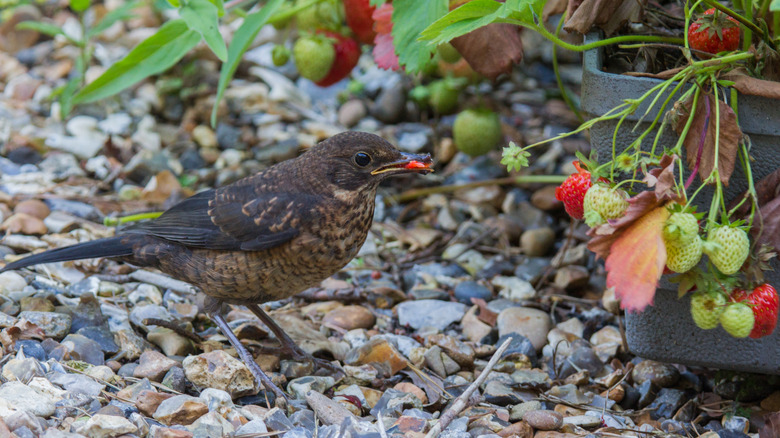The Garden Decor DIY That Also Protects Your Strawberry Plants From Birds
Growing and caring for strawberry plants doesn't require loads of prior experience nor a huge backyard, but there are some essential steps to keep in mind. Sunshine is the first key to success, as strawberries need at least six hours of direct sunlight a day. What's more, plants should be planted 12 to 18 inches apart and receive about 1 inch of water a week. Another aspect to consider is predators and, more specifically, how to keep them at bay. Berried plants are sure to attract birds to your garden. While that can be lovely, you don't want them eating your sweet treats.
A great way to stop birds feeding on your strawberries is to get ahead of the game. Before they even begin to grow, you can use a simple rock DIY to protect your strawberry plants from predators. The trick is to turn pebbles into decoy strawberries and scatter them around the real deal to attract birds early on in the season and teach them a lasting lesson. As they try to peck at the faux fruit, they will quickly realize it's not edible and leave. When they spot actual strawberries later on in the season, they'll simply assume they're hard and unappetizing like the first time they tried them.
How a simple rock DIY can protect your strawberries
One tried-and-true secret to a luscious strawberry harvest is to protect your fruit with a floating row cover draped with netting. You could also try hanging shiny CDs or DVDs from a post to scare birds aways, but neither of these options are particularly aesthetically appealing. Instead, British gardening influencer and writer Rob Smith recommends placing strawberry-looking pebbles all around the real plant as it can work wonders. "By doing this when plants aren't fruiting, the birds will learn that strawberry red 'fruit' are hard and inedible," he explained in a video on Instagram.
Scour your backyard for pebbles and rocks that are about the size of a ripened strawberry. Use water and a brush to rinse off any mud and debris, as needed. Once clean and completely dry, they're ready for painting. Covering them with a red Rust-Oleum spray paint is the quickest method to get full coverage, however, there's also room for some creativity. Using acrylic paints, you can add green leaves and black dots to mimic seeds, achieving a pretty result that's both beautiful and functional. To finish, simply place your fake strawberries in spots where they would grow naturally and where there isn't too much foliage, so birds can spot them and the ruse can work to its full effect.
